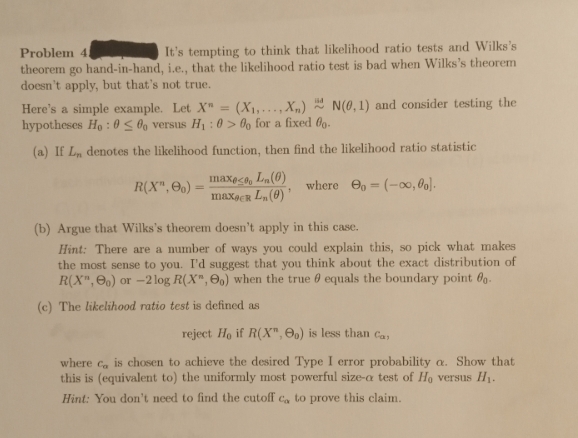Problem 41 It's tempting to think that likelihood ratio tests and Wilks's theorem go hand-in-hand, i.e., that the likelihood ratio test is bad when

Problem 41 It's tempting to think that likelihood ratio tests and Wilks's theorem go hand-in-hand, i.e., that the likelihood ratio test is bad when Wilks's theorem doesn't apply, but that's not true. Here's a simple example. Let X" = (XX)N(0, 1) and consider testing the hypotheses Ho: 000 versus H: 0>00 for a fixed 00- (a) If L, denotes the likelihood function, then find the likelihood ratio statistic maxes, L(0) R(X",00) = maxger Ln(0) where -(-00,00]. 1 (b) Argue that Wilks's theorem doesn't apply in this case. Hint: There are a number of ways you could explain this, so pick what makes the most sense to you. I'd suggest that you think about the exact distribution of R(X",e) or -2 log R(X", e) when the true 0 equals the boundary point 60- (c) The likelihood ratio test is defined as reject Ho if R(X", eo) is less than Ca where ca is chosen to achieve the desired Type I error probability a. Show that this is (equivalent to) the uniformly most powerful size-a test of Ho versus H. Hint: You don't need to find the cutoff ca to prove this claim.
Step by Step Solution
There are 3 Steps involved in it
Step: 1

See step-by-step solutions with expert insights and AI powered tools for academic success
Step: 2

Step: 3

Ace Your Homework with AI
Get the answers you need in no time with our AI-driven, step-by-step assistance
Get Started


